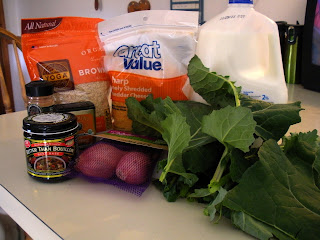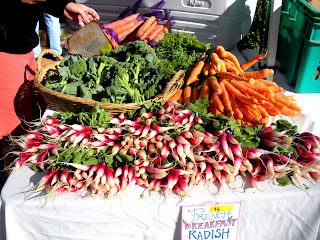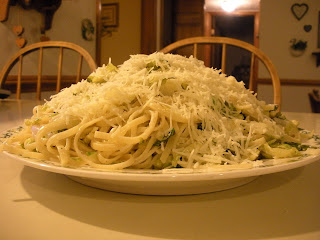This week my vegetable of choice was a popular fall/winter green – kale. The decision to use this particular vegetable was fairly easy. I hadn’t looked for anything in the grocery store, but when I mentioned to my mom that I wanted to cook something for my blog, she told me that there was fresh, organic kale out in the garden ready to be picked. Perfect! I had seen a recipe awhile back for a brown rice and kale gratin, so I knew this would be the perfect opportunity to try it out.
First of all, I should start out with a confession. Having not been a particularly vegetable-loving kid, when I was younger I thought that the broad category of “greens” was actually a specific vegetable. Collards, kale, mustard greens, spinach – they all looked the same to me, smelled the same to me, and repulsed me equally. The only experience I had with “greens” was on New Year’s Day when my mom would make me eat a bite of them because, as the superstition goes, eating collards on New Year’s Day will bring wealth in the coming year. Black eyed peas were another part of the same tradition; eating them allegedly brings good luck. Well I couldn’t stand the taste of either. I thought black eyed peas tasted like dirt and “greens” (collards) tasted like vomit. But every year without fail I would be told that I had to eat these two things on January 1st. New Year’s dinner was probably my least favorite meal of the year because of this. My family would watch as I would cut open a roll, stuff one single black eyed pea in the middle along with one tiny shard of a collard leaf, and then take a bite. I’d try to chew as little as possible, resulting in my almost literally choking the roll with the vegetable passengers down my throat. Needless to say, up until today, my experience with “greens” had not been pleasant.
Of course as I got older I came to realize that “greens” was not a single vegetable. It was in fact a whole group of vegetables that share similar health benefits but have different tastes and growing seasons. Kale likes cold weather, growing sweeter after a frost. It can grow well into the winter, earning the nickname “Hungry Gap,” named after the period in winter in traditional agriculture when little can be harvested. Nutritionally, kale has many benefits. One cup of kale contains 36 calories, 5 grams of fiber, and 15% of the daily requirement of calcium and vitamin B6 (pyridoxine), 40% of magnesium, 180% of vitamin A, 200% of vitamin C, and 1,020% of vitamin K. It is also a good source of minerals copper, potassium, iron, manganese, and phosphorus.
Interestingly, kale has been around since ancient times. Recently in my classroom we have been studying the ancient civilizations of Greece and Rome. Last week I wanted to take my students on a “field trip without leaving the classroom” so I had students volunteer to prepare and bring in traditional Greek recipes. We sampled the cuisine while watching a scenic video on Ancient Greece and I encouraged the kids to use their imagination and pretend that they really weren’t in the classroom but instead were in the valleys in Athens, gazing up at the Parthenon on the acropolis. At the time I didn’t realize it, but kale was actually a vegetable commonly eaten in both ancient Greece and Rome. Next year I’ll have one more recipe to add to the list of foods that students can prepare! There are many different varieties of kale, and it was the Russian variety that eventually moved into Canada and then the United States.
I’m a firm believer that anything tastes better with cheese, so I decided that when trying a kale recipe it was probably a good idea to try one that required large amounts of cheddar. To start, melt 3 tablespoons butter in a heavy bottomed pan. (Oh, butter also makes anything taste better. This recipe just HAD to be good). Next add one large shallot that has been minced. Sauté the shallot until it is lightly browned. Add 2 cups brown rice and sauté with the shallot for about 5 minutes, until the rice is a little toasted.
Next add 6 cups 2% milk, 2 teaspoons beef bouillon concentrate, ¼ teaspoon nutmeg, and ¼ teaspoon cayenne pepper. Bring to a boil, reduce heat to a simmer, cover, and cook for 45 minutes to an hour. Most of the liquid will be absorbed, resulting in a paste-like consistency.
Next add 2-3 cups of chopped kale and cook for about 5 more minutes to soften the kale.
Spoon the mixture into a greased 13x9 inch baking dish. Top with 8 ounces (or more!) cheddar cheese and ½ cup bread crumbs. Bake in a 350° oven for 30 minutes or until the cheese is melted and bubbly.
And that’s it! It’s a pretty simple recipe, but it resulted in a very hearty dish. I will say that I actually really enjoyed the kale in this recipe, and call me crazy, but next time I think I might even add a little more kale than what the recipe calls for. It was definitely more rice than kale, and I think a more even balance between the two would be really good. With that being said, I still thought this recipe was delicious and can’t wait to eat the leftovers the rest of the week. I’ll also look forward to making this dish again! I guess I am officially over my fear/hatred of “greens”!
































































